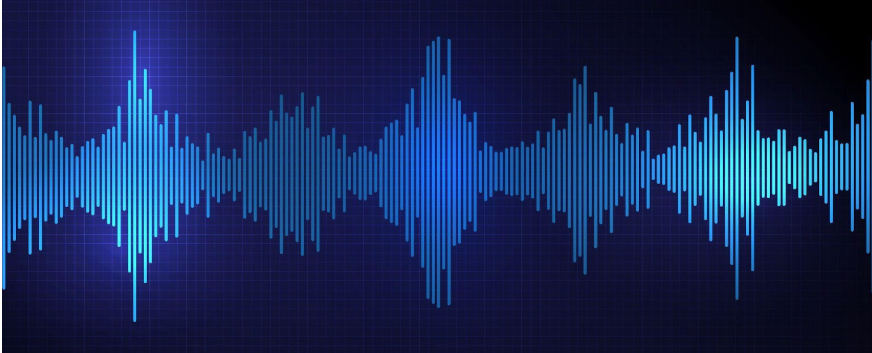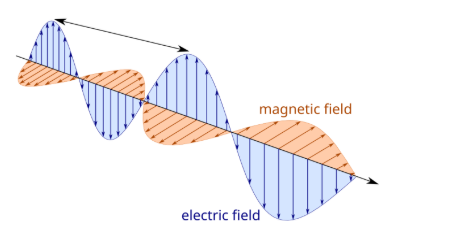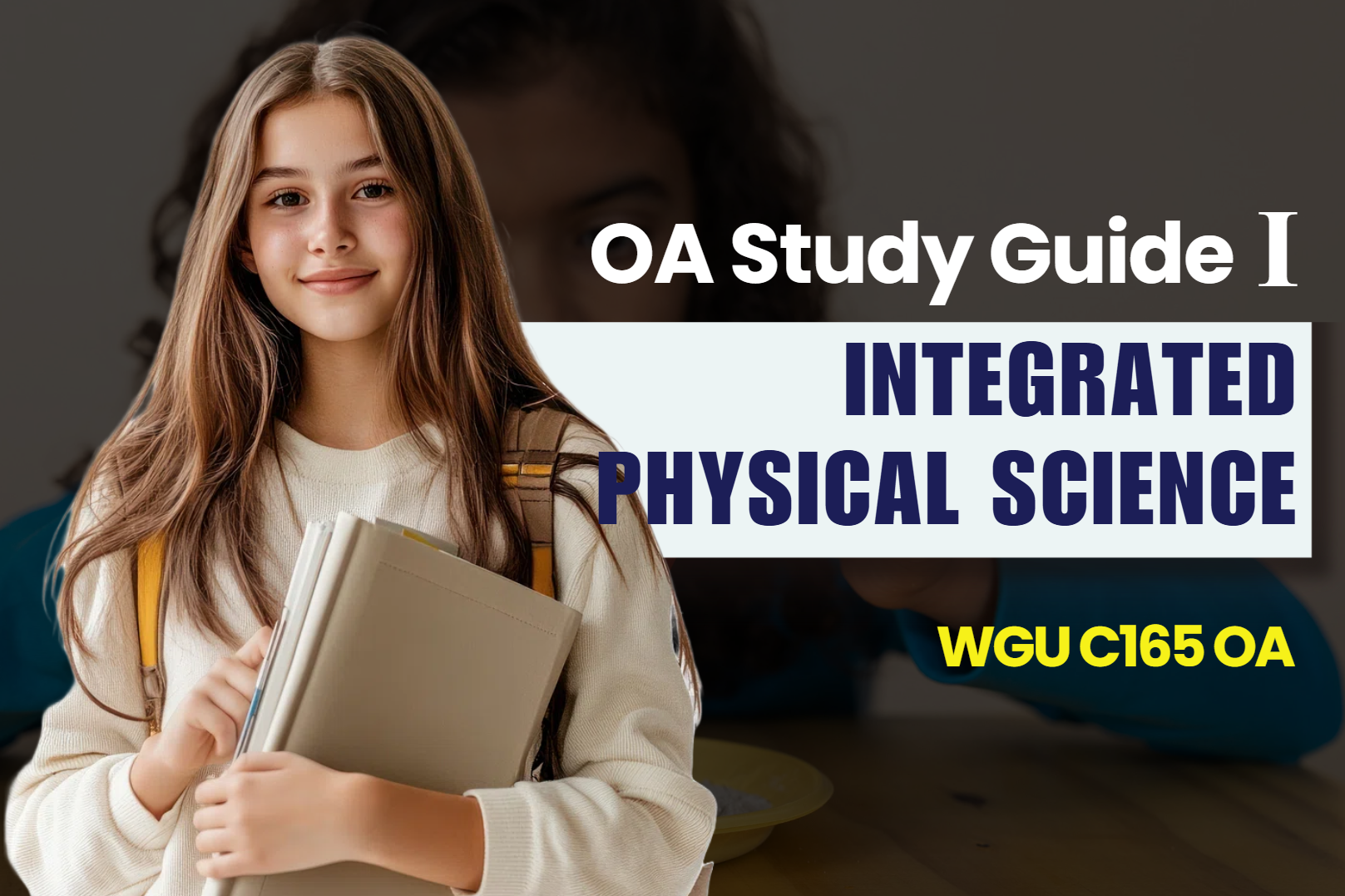WGU C165 OA Study Guide I- 2025 | Understanding the Building Blocks of the Universe 📖
Welcome to your crash course in waves and scientific reasoning, where we break down some of the coolest concepts in physics—like how sound waves travel to your ears and what makes the universe tick (yes, it’s that cool). The article examines essential knowledge for WGU C165 studies through an analysis of wave properties together with an explanation of hypothesis-theory-law distinctions. The complex words should not scare you right now. WGU C165 presents you with a chance to become both a wave whisperer and a science detective at the same time.
This article explores two fundamental scientific concepts that are essential for understanding natural phenomena and scientific reasoning:
- Properties of Waves: Waves are disturbances that transfer energy from one place to another. They have key properties such as wavelength, frequency, amplitude, and speed, which determine how they behave in different mediums, from water to sound and light.
- Differences Between Hypotheses, Theory, and Law: In science, hypotheses, theories, and laws serve different purposes. A hypothesis is an educated guess that can be tested, a theory is a well-supported explanation of natural events, and a law is a statement that describes a consistent natural occurrence.
At the end of this piece, you will confidently master the key concepts needed to address WGU C165 OA questions. Let’s get started, shall we?
How to Use This Guide for the WGU C165 OA Exam?📖
The C165 Integrated Physical Sciences OA exam at WGU evaluates your understanding of scientific inquiry, experimental design, and the fundamental concepts of physical sciences. This guide simplifies the key concepts of properties of waves and the differences between hypotheses, theory, and law to help you grasp the topics tested in the exam.
We also provide exam-style questions and practical applications to ensure you’re fully prepared for the questions on the WGU C165 OA exam.

Properties of Waves: Understanding the Basics For C165 OA📝
Waves surround our everyday life in all forms from sound waves during musical presentations to ocean waves and also the waves that make visible sunlight. But what exactly is a wave? Waves represent moving disturbances that transport power across both open space and physical substance. Waves present themselves in numerous ways yet they demonstrate shared qualities that aid us in understanding their behavior while interacting with our environment.
The next part will examine major wave characteristics, their distinct types, and their unique attributes. Understanding these wave properties is important not just for general knowledge but also for tackling WGU C165 OA questions, which often test your understanding of wave concepts. By grasping the basics of wave behavior, you’ll be better prepared for the challenges in the WGU C165 module on Integrated Physical Sciences.
Key Properties of Waves

Every wave has specific fundamental properties that need study before moving forward to waveform classifications. The defining characteristics of waves exist in mechanical sound waves as well as electromagnetic light waves which establishes their wave nature.
- Amplitude: The amplitude of a wave refers to the height of the wave from its resting position, also known as the equilibrium. A wave with a larger amplitude carries more energy. For example, when you hear a loud sound, it’s due to the higher amplitude of the sound waves. The louder the sound, the higher the amplitude.
- Wavelength: The wavelength is the distance between two consecutive crests (the highest points) or troughs (the lowest points) in a wave. For light, wavelength determines its color, and for sound, it determines its pitch. Shorter wavelengths mean higher energy, while longer wavelengths mean lower energy.
- Frequency: This property describes how many waves pass a given point in a specific amount of time, usually measured in hertz (Hz). A higher frequency means more waves passing by per second. This is why we can hear different pitches in sound – higher-frequency waves correspond to higher-pitched sounds.
- Wave Speed: A wave achieves its movement speed through a medium according to the rate at which it advances. The wave speed depends on both wave type and travel medium characteristics. In a vacuum, light waves exceed the velocity of sound waves by vast amounts.
- Crest and Trough: Each wave consists of upper points known as peaks and lower points referred to as valleys. The maximum point of a wave forms its crest although the lowest part creates its trough. The wave energy assessment depends on the elevation between wave peak and trough points. The wave energy directly correlates with the vertical distance between its highest and lowest points.
Types of Waves
Different wave types exist according to their travel patterns as well as their medium requirements. Examining these distinct wave categories lets you understand different wave behaviors to properly answer questions in WGU C165 regarding wave behavior characteristics.
- Mechanical Waves: These are waves that require a medium (like air, water, or solid materials) to travel through. Mechanical waves cannot move through a vacuum because they need particles to transmit their energy. A good example is sound. When sound travels through air, it moves as a mechanical wave. Other examples of mechanical waves include water waves and seismic waves.

- Longitudinal Waves: The moving pattern of medium particles in longitudinal waves follows the same path as the wave travels. A sound wave serves as a typical illustration of this wave category. Sound waves make air molecules compress and expand while they travel thus they generate alternating volumes of high and low pressure. The alternating pressure changes result into compression and rarefaction patterns.
- Transverse Waves: Unlike longitudinal waves, transverse waves move the particles of the medium perpendicular (at right angles) to the direction of wave propagation. Think of a wave moving along a rope or string. The particles move up and down as the wave travels horizontally. Light waves and water waves are also examples of transverse waves.
- Longitudinal Waves: The moving pattern of medium particles in longitudinal waves follows the same path as the wave travels. A sound wave serves as a typical illustration of this wave category. Sound waves make air molecules compress and expand while they travel thus they generate alternating volumes of high and low pressure. The alternating pressure changes result into compression and rarefaction patterns.
2. Electromagnetic Waves: Such waves differ from others because they propagate without the need for a medium. Such waves can pass through a complete void since their composition involves shifting electric and magnetic fields. Light waves together with radio waves as well as X-rays microwaves and gamma rays make up electromagnetic waves. They all travel at the speed of light in a vacuum (about 300,000 km per second).

- People experience electromagnetic waves in the form of light all the time. Light waves enable human beings to visually perceive the objects in their surroundings. Electromagnetic waves propagate through space without using particles to transmit energy since these waves perpetually alter the strength patterns between electrical and magnetic fields.
- People experience electromagnetic waves in the form of light all the time. Light waves enable human beings to visually perceive the objects in their surroundings. Electromagnetic waves propagate through space without using particles to transmit energy since these waves perpetually alter the strength patterns between electrical and magnetic fields.
Wave Characteristics: Understanding Wave Behavior
Understanding the behavior of waves is crucial when tackling WGU C165 OA questions that focus on wave theory and principles. By learning about wave characteristics, you can begin to predict and explain how waves interact with each other and with their surroundings.
- Reflection: Any wave returns back to its origin point after striking a surface. A mirror reflects light as it does with sound when it encounters a wall. Reflection occurs in every wave type regardless of whether we speak about sound waves or light waves.
- Refraction: Refraction happens when a wave changes direction as it moves from one medium to another. For instance, when light passes from air into water, it bends, and this bending is called refraction. This is why a straw appears to bend when placed in a glass of water.
- Diffraction: Waves experience bending that occurs during their passage through obstacles or apertures. Waves expand after going through restricted areas because of the process known as diffraction. All three types of waves show this phenomenon: water waves sound waves and light waves.
- Interference: Interference occurs when two waves meet and combine in different ways. There are two types:
- Constructive interference: This happens when two waves combine to form a wave with a larger amplitude.
- Destructive interference: This occurs when two waves combine to cancel each other out, resulting in a smaller or no wave at all.
By understanding these basic wave properties, types, and behaviors, you can start to build a solid foundation in wave theory. These concepts will be crucial for your success in the WGU C165 OA, where you’ll encounter questions related to how waves interact, propagate, and transmit energy.
Next, let’s dive into understanding the critical differences between hypotheses, theory, and law, a concept that is essential for mastering WGU C165 OA questions and building a solid foundation in scientific inquiry.
Differences Between Hypotheses, Theory, and Law For C165 OA 📝
Research in the world of science demands basic knowledge about the distinct roles of hypothesis theory and law. The scientific terms often get mixed up yet maintain unique definitions which fulfill separate functions throughout research procedures. Knowledge of these concepts remains essential for WGU C165 OA tests and for a comprehensive study of scientific investigation in the Integrated Physical Sciences module.
This section provides definitions along with explanations of roles that demonstrate how scientific concepts progress and/or testing occurs in real-world scenarios.
What is a Hypothesis?
A hypothesis is the starting point of scientific inquiry. It’s an educated guess or a testable statement that suggests a possible explanation for a phenomenon based on observation and research. Think of it as a prediction or a tentative answer to a scientific question. Scientists propose hypotheses before conducting experiments or making detailed observations.
Here are some important characteristics of a hypothesis:
- It is testable. This means it can be supported or rejected based on the results of experiments or observations.
- A hypothesis is typically specific to a particular test or observation.
- It is not yet proven. The results of the experiment will help confirm or refute it.
- A hypothesis is often an educated guess that makes predictions about what might happen in a given experiment.
Example: Suppose you notice that plants seem to grow taller when they receive more sunlight. Your hypothesis might be: “If plants get more sunlight, then they will grow taller.” This is something that can be tested through controlled experiments.
What is a Theory?
A theory presents a thoroughly supported explanation that describes natural world phenomena. The theory exists through a substantial accumulation of evidence collected from numerous trials and observations. A theory surpasses a hypothesis because it experiences extensive testing before obtaining its ability to explain the root causes.
Here are the key aspects of a theory:
- It answers the “why” behind a phenomenon. A theory explains the underlying causes or reasons for the observed patterns in nature.
- Theories are built upon extensive data and experimentation. They have undergone rigorous testing over time and have been validated by many scientists.
- A scientific theory is typically widely accepted and explains a general principle that can be applied in multiple instances.
- Even though a theory is well-supported by evidence, it is still open to modification or rejection if new evidence contradicts it.
Examples:
- The Theory of Gravity: The theory demonstrates how objects fall toward Earth by combining the concepts of Isaac Newton and Albert Einstein. Multiple tests have proven it and an enormous amount of evidence backs up its validity.
- The Big Bang Theory: Surrounding the birth of everything in our existence stands the Big Bang Theory which shows how everything originated from a single point followed by vast cosmic expansion.
A theory is not just a guess; it is a well-supported explanation of a phenomenon that can incorporate facts, laws, and previously tested hypotheses.
What is a Law?
A law is a scientific statement that describes a pattern in nature that has been observed to be consistent and universal under specific conditions. Laws generally describe how something happens, often in the form of a mathematical equation. While theories explain why something occurs, laws simply describe what happens.
Some important points about laws:
- A law is often expressed mathematically. For example, Newton’s Second Law of Motion is written as F=maF = maF=ma, describing the relationship between force, mass, and acceleration.
- A law is universal within the specific conditions under which it applies. It describes how things behave when certain factors are in place.
- Laws do not explain why a phenomenon occurs; they only describe the pattern observed in nature.
- They are consistent across experiments and observations. A law does not change based on new evidence as easily as a theory might.
Examples:
- Newton’s Laws of Motion: According to Newton the Laws of Motion establish how moving objects and interacting objects respond to forces. According to the law of inertia, any object will stay still or keep its current motion only when it faces no outside disturbance.
- The Law of Conservation of Mass: States that matter cannot be created or destroyed in a chemical reaction.
While laws provide a description of patterns and relationships, they do not delve into the reasons behind these patterns—that’s the job of theories.
Key Differences Between Hypotheses, Theory, and Law
Now that we’ve defined each term, let’s summarize the key differences to help you clearly understand how they relate to each other:
Feature | Hypothesis | Theory | Law |
Purpose | To propose an explanation or prediction | To explain why something happens | To describe a pattern or phenomenon |
Formation | Before conducting experiments | After repeated testing and evidence | After many observations and experiments |
Certainty | Uncertain, testable | Well-supported by evidence | Universally consistent under conditions |
Scope | Specific to a test or observation | General principle, applicable in many situations | Universal and specific to certain conditions |
What It Tells | “What might happen?” | “Why does it happen?” | “How does it happen?” |
Relation to Other Concepts | Can lead to a theory if proven | Explains phenomena, can incorporate facts, laws, and hypotheses | Often expressed as a mathematical equation |
Important Considerations For C165 OA
- Hypothesis comes before theory: A hypothesis is always formed before a theory. A hypothesis leads to experiments that may eventually help build a theory.
- Theories don’t become laws: It’s a common misconception that theories can evolve into laws. In reality, a theory explains why something happens, while a law describes how it happens. They are separate, and a theory does not turn into a law.
- Testing and Evidence: While hypotheses are not proven initially, theories and laws are supported by strong evidence collected through repeated experiments. A hypothesis must be tested and either supported or refuted, while theories and laws rely on consistent, repeated observations and experiments.
Tired of reading blog articles?
Let’s Watch Our Free WGU C165 Practice Questions Video Below!

Nailing the WGU C165 OA: Mastering Waves and Scientific Concepts📖
Congratulations! You’ve now got the lowdown on two of the most essential topics in your WGU C165 journey: the properties of waves and the distinctions between hypotheses, theories, and laws. These concepts are not just for the classroom—they’ll be key to your success in the WGU C165 OA, where your understanding of these topics will really shine.
As you prepare for the final OA, make sure to really grasp these ideas. Whether it’s understanding how waves carry energy or knowing how scientists differentiate between a hypothesis, a theory, and a law, the more solid your foundation, the easier the challenges will be.
Good luck with your studies, and remember—waves might seem tricky at first, but once you get the hang of it, you’ll be riding the wave of success straight to your goals in WGU C165! Keep going, you’ve got this!






